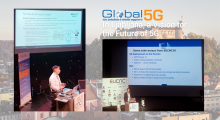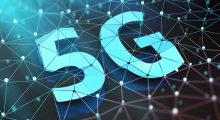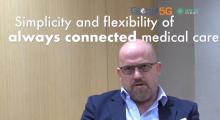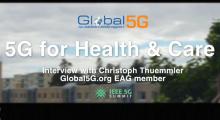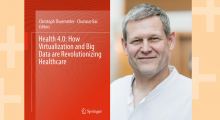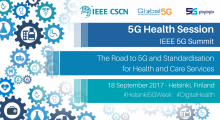
5G for Health
The healthcare industry is the biggest and fastest growing industry in the world. Despite the potential of digitisation, the anticipated impact in healthcare is yet to be seen, including patient outcomes like improved patient engagement, connected care, unobtrusive monitoring and assisted living for people with chronic conditions, independent and active ageing.
Yet requirements for 5G-enabled health services are similar all around the globe, and therefore standardisable, such as having common standards for recording, sharing, transferring and anonymising health-related data.
5G Health: a groundbreaking opportunity
5G is an engine for innovation across many sectors. Healthcare is no different. The advent of seamless connectivity with guaranteed levels of performance including low latency, high throughput and reliability, smartphones and mobile apps, cloud services and smart connected devices, can enable distributed, patient-centred delivery at multiple points of care, individualised health information and the ability to track patient health metrics powered by big data analytics.
Such scenarios can create new avenues in personalised care, early remote diagnosis, remote surgery, and smart hospitalisation logistics. Increased accessibility to data will enable optimisation in intervention planning (e.g. transplant scenarios), lead to greater transparency, and improve overall patient engagement with healthcare providers.
A decentralised healthcare model
Industry findings point to the following trends1:
- Healthcare becomes decentralised.
- Point of care shifts increasingly towards homes.
- Patient data is centralised with hospitals becoming data centres.
Socio-econonmic impact: healthcare becomes more sustainable in view of demographic trends and the ageing society with increasing costs. Decentralised healthcare is also an opportunity to bring about significant improvements in patient quality of life, such as chronic disease management and assisted living for the ageing population.
Socio-economic impact: reducing costs and time to access medical specialists, avoiding long waiting lists and complex logistics for rural dwellers. A 5G-enabled decentralised healthcare model will allow remote consultation, diagnosis and health checks, making specialised and high-quality care more affordable for more people
The importance of 5G health use cases
“One of the greatest barriers to 5G health development is the lack of communication: relevant players need to fully understand the revolutionary benefits and opportunities of 5G” (Christoph Thuemmler – professor at Napier University, Edinburgh, UK and Global5G.org EAG member, interviewed at IEEE 5G Summit, Helsinki Sept. 2017). It is crucial to bring together mobile and network professionals with healthcare stakeholders so they get a shared understanding of the technology potential and specific use case requirements.
Use cases will play an important role in laying the foundations for the uptake of 5G Health. This means investigating two categories of requirements: 1) user-driven requirements in terms of Quality of Experience, Quality of Service, user satisfaction and speed of the connection and 2) network-driven requirements in terms of network operation and management.
Consensus on standards
There is consensus that 5G will be an enabler of medical internet of things (MIoT). With the scaling of healthcare devices and sensors, we are at the dawn of the Industrial Internet of Things. Despite the ever increasing number of connected IoT devices gathering and processing huge amounts of health data, healthcare is still an astonishingly fragmented industry and standardisation of data formats and protocols in the health sector is far to be seen. It is now urgent to converge by gaining wide consensus around health related standards with a priority on interoperability-by-design. Interfacing between different industries and health verticals: hospitals, pharmaceutical industry, medical device manufacturers, health authorities.
Stakeholders should also consider the development of a reference architecture in response to specific industry challenges, spanning network slicing, cross-domain orchestration and service aggregation on edge cloud level, governance and privacy). For example, technology advances like SDN-NFV based network slicing are expected to meet high resilience, security, privacy and availability requirements, but consensus is still lacking on even basic definitions of slicing (ETSI 5G Summit 2017).
Supporting IEEE medical technology standardisation efforts with special focus on 5G, e.g. IEEE 802.15.6 –Body Area Networks.
Challenges: regulations, security, privacy
To realise its full potential, the healthcare sector will require a very supportive regulatory framework and common standards. Different policies need to underpin developments in healthcare, ranging from issues like transparency, data ownership, privacy, data exchange, permissions around offering services, and liability issues. Security and privacy are important in this highly regulated industry and will only increase in importance with the General Data Protection Regulation and the Directive on Network and Information Systems.
How Global5G.org for Health can help
Global5G.org for Health is here to help: find out more about 5G Health use cases, navigate relevant standardisation efforts and timelines with our standard tracker, and get the pulse of the new business landscaping with our market watch.
Events
06/18/2018 to 06/21/2018
EuCNC2018 Workshop WS1: Vertical Industries & Services for 5G (VIS5G)
02/12/2018 to 02/13/2018
The European 5G Conference 2018
The European 5G Conference will take place on 12th & 13th February 2018 at the Steigenberger Wiltcher’s Hotel, Brussels.
11/01/2017 to 11/03/2017
BIT’s 5th Annual Global Health Conference-2017(AGHC-2017)
BIT’s 5th Annual Global Health Conference-2017(AGHC-2017 ) will be held in Taiyuan, China on November 1-3, 2017.




